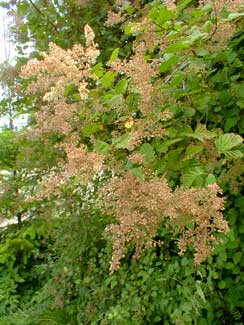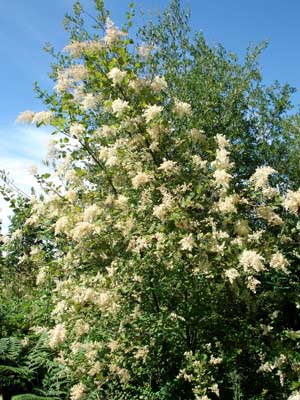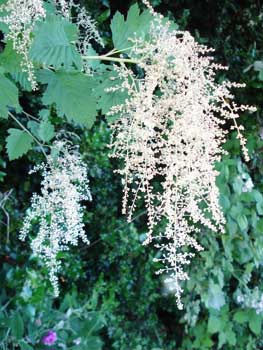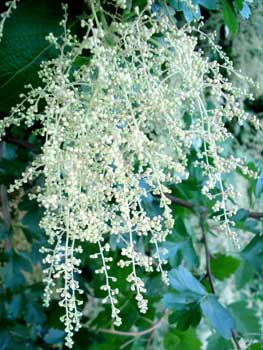
Oceanspray
"The deeper we look into nature, the more we recognize that it is full of life, & the more profoundly we know that all life is a secret & that we are united with all life that is in nature."
-Albert Schweitzer
(1875-1965)
(1875-1965)
 Oceanspray (Holodiscus discolor) grows throughout the Pacific Northwest from British Columbia to California, & inland to Montana & Idaho, with a few populations in Utah & Nevada. It is particuarly common west of the Cascade Mountain range & in the northern Rockies.
Oceanspray (Holodiscus discolor) grows throughout the Pacific Northwest from British Columbia to California, & inland to Montana & Idaho, with a few populations in Utah & Nevada. It is particuarly common west of the Cascade Mountain range & in the northern Rockies.It grows in areas of seasonally heavy rainfall but on droughty slopes or at forest edges & along highways, on cliffsides overlooking the ocean, straits, & all along Puget Sound, being very hardy in salt air maritime conditions.
Oceanspray arrives quicky on recently disturbed sites like forest clear-cuts or cut-throughs for roads. In some such locations they are the dominant shrub, as also on rocky slopes that don't hold moisture well or have very little good soil & so don't sustain pickier shrubs. Their happiness in droughty conditions doesn't mean they can't stand moisture, as they are also encountered along edges of streams on high enough banks to drain well.
In our peninsular county they self-select areas in full sun though I have seen extra tall specimens standing particularly upright seeking sunlight from quite shady positions, these shaded giants being less attractive shrubs by & large well-leafed only at the top. Inland they may prefer a bit of protection from the harshest summer sun, but around Puget Sound full sun is where they look choicest.
 It gets its name Oceanspray from its common appearance on cliffs & walls overlooking saltwater bays, & for the large drooping panicles of tiny flowers that can look like frothy ocean foam. The less often used name Creambush or Cream Bush is likewise for the frothy-looking blooms.
It gets its name Oceanspray from its common appearance on cliffs & walls overlooking saltwater bays, & for the large drooping panicles of tiny flowers that can look like frothy ocean foam. The less often used name Creambush or Cream Bush is likewise for the frothy-looking blooms.The slender stems & twigs are surprisingly hard & were used by first peoples to make arrows & small tools, hence the alternative names Arrow-wood or Ironwood. It was formerly assigned to the genus Spiraea & still sometimes called California Spirea or Rock Spirea due to the resemblance, or Western Meadowsweet because the flowers have a scent resembling meadowsweet (Filipendula ulmari). Their scent has sometimes been described as "old newspapers" from close up, but from any distance they provide a sweet woodsy perfume.
They are loose twiggy shrubs that can seem almost invisible along the forest margins, vanishing into the general wall of greener, except when in flower, when it is suddenly quite obvious that they are everywhere in great numbers. They are lightweight for their size with a shallow root system, so they can cling to every rocky hillside where other large shrubs less easily gain footholds, hence are valued for erosion control on just such sites. In decades past, sad to say, the now invasive scotch broom was used for erosion control on disturbed slopes, where today native oceanspray is preferred.
 Inland & in the Rockies, Oceanspray reaches six or eight feet high & wide, but our wild coastal specimens easily reach fifteen & even twenty feet. Not likely to get so big in gardens, they are nevertheless substantial shrubs which if outgrowing their location can be hard pruned practically to the ground to start over, but lighter pruning alas seriously interferes with flowering, so it's best if they are in a location where they can be happily neglected & permitted their fullest reach.
Inland & in the Rockies, Oceanspray reaches six or eight feet high & wide, but our wild coastal specimens easily reach fifteen & even twenty feet. Not likely to get so big in gardens, they are nevertheless substantial shrubs which if outgrowing their location can be hard pruned practically to the ground to start over, but lighter pruning alas seriously interferes with flowering, so it's best if they are in a location where they can be happily neglected & permitted their fullest reach.The first photo is a late July shot of the flowers after they begin to turn brown, on an eight by eight foot shrub on the edge of a friend's property. The second photo, from earlier in July, shows a twenty-five foot shrub growing around the corner from the Garden of Paghat the Ratgirl. Diagoro likes to pee on that one when we go for walks. The close-up photos are from that same shrub in June when the blooms were at their height.
They can bloom anywhere from May to July but in our county they are at their peak of flower in late June & early July. For abouit four weeks their large bright white panicles are seen everywhere, then for an even longer period the blooms are drying to a chocolaty or grey-brown, with seeds ripening by autumn & lingering on the branches through much of winter. They're among the first deciduous shrubs to releaf in spring.
Pioneer Oregonians used either the bark or dried & pulverized the leaves to store for use when needing an antesceptic for burns or abrasions. Native peoples of Vancounver Island brewed a tea from the flowers & seeds or from the roots, for treating diarrhea or even to treat serious contageous diseases, though its efficacy was never widely attested & it seems not to have been so-used in many areas of its extensive range.
The flowers were also regarded as edible, though I find it hard to imagine what sort of recipe would make them worth harvesting outside of emergency survival needs.
For cattle it is an important summer browse shrub especially in Idaho, growing back rapidly after being browsed. It's equally important to elk & black-tail deer. In less dry times of the year when there is plenty of green grass, it is not so much utilized by browsing animals, being a mite bitter so only used as back-up forage in dry summers.
Oceanspray is easily propagated by collecting seeds but they are very difficult to start from cuttings. If tried from cuttings, take half-ripe wood with heel, dab the heel in rooting hormone, & attempt to get them started under coldframes. When large specimens are provided by nature on property edges, it is a nice idea to preserve them as native in place as fine ornamental shrubs. They are also available nursery-grown in pots from native plant specialists.
Due to their size they're not invariably useful for small suburban gardens, though many people plant equally large butterfly bushes or forsythia in small gardens, & Oceanspray would be a better choice for anyone who wanted to keep their garden native-plant oriented or who just wanted someting a lot less commonly planted. For us northwesterners it is a choice native shrub for encouraging our local species of butterflies.